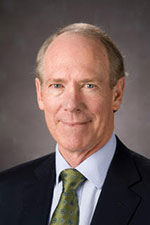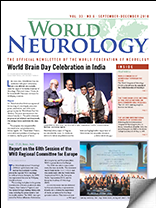The World Congress of Neurology (WCN) is the jewel in the calendar of the World Federation of Neurology (WFN). A just completed site visit to Rome and the final site visit for Dubai scheduled for December prompted the topic for this issue of the President’s column. Until the 2011 Congress held in Marrakesh, Morocco, World Congresses had been held every four years. From 2011, the WFN recognized that with the increasing number of high quality neurology meetings the WCN was at risk of being made relatively invisible. The 2011 WCN was a test of a biennial Congress and one which proved most successful.

William Carroll, MD
Importance
To the WFN, the WCN is of paramount importance for a number of reasons. First, it is the major educational effort of the WFN. All other educational activities undertaken by the WFN, including regional training centers, regional teaching courses, department visits, junior traveling fellowships and research grants may be of importance but they can never exceed that of the WCN. It comprises the end result of two years of intensive planning and the contribution of the world’s best experts for the topics selected for each WCN.

Kyoto, Japan, the site of the XXIII world congress.
Not only is it the flagship educational vehicle of the WFN, it also provides the major contribution to the lifeblood of the WFN. Without the income that the WCN generates, the WFN activities would be severely curtailed in what it could achieve each and every year. By being such a visible and important meeting, it highlights the emphasis with which the WFN promotes education in neurology.
It is fair to say that the WCN sets a high standard for a broad range of attendees through the structure and the content of its scientific and educational course programs. I will say more on this below.
History of the Early World Congresses of Neurology

Marrakesh, Morrocco, the site of the 2011 WCN.
The WFN WCNs grew out of the same desire of neuroscientists and neurologists to form an international organization and hold a regular internationally recognized meeting. Understandably, these meetings underwent some early evolution in format, structural organization and title before being recognized as the WFN’s WCN, which is evident below.
The First International Neurological Congress, known as the Sixth International Congress of Neurological Sciences, was held in Brussels in 1957, during which the WFN was founded. As former WFN President Johann Aarli, states in his book, “The History of the World Federation of Neurology”1, the Sixth International Congress was more comprehensive in the neurosciences and effectively became the first International Neurological Congress. It was not until the following International Neurological Congress, the seventh, held in Rome in 1961, that the active participation of the WFN as an independent organization occurred. Nevertheless, as is shown below, the Brussels International Congress of Neurological Sciences became the Sixth World Congress of Neurology and the Rome International Neurological Congress became the Seventh World Congress of Neurology for ease of numerical sequencing. The 25th World Congress of Neurology, to be held in 2021, will be in Rome and will therefore be a special celebration for 60 years of World Congresses of Neurology. Indeed, only two other venues have held a WCN twice: Vienna in 1965 and Kyoto in 1981 which had the honor again in 2013 and 2017, respectively. Kyoto was the most successful to date in numerical attendees, and Vienna was one of the most profitable. It was not until the 1981 Congress in Kyoto that the appellation World Congress of Neurology appeared to be formally adopted and the meeting was known as the 12th WCN.
The Modern Era

The Cloud/La Nuvola, Rome, Italy, the site of the World Congress of Neurology in 2021.
From 2009, the frequency, venue selection and organization of the WCN changed. Congresses became biennial, rotated sequentially by global quarters (Asia, Africa and Middle East, Europe, and the Americas) and the WFN assumed overall responsibility for the WCN organization, and retained 60 percent of the profits, thus enabling less well-endowed regions and venues to be selected and so increase the “reach” of the WCN.

Dubai, the site of the XXIV world congress.]
Even though the local host society no longer acted on behalf of the WFN in the organization of the WCN with a 50 percent division of profits, the local host society retained for each WCN the essential and important “local” element which distinguishes a WCN from the other regular global meetings.
Also important for the development of the regional representative organizations was the ability for the local host WFN member society to enter into a formal cooperative arrangement with the regional organization to their mutual financial and developmental benefit. For example, the Moroccan Society partnered with the Pan Arab Union of Neurological Societies in the organization of the 2011 WCN and pledged a portion of their profits to the still emerging African Academy of Neurology.
World Congresses and Their Venues
The Sixth International Congress of Neurological Sciences was also known as the First International Neurological Congress. Brussels 1957
Seventh International Neurological Congress also known as the Second International Congress of Neurology. Rome 1961
Eighth International Congress of Neurology also known as the Third International Congress of Neurology. Vienna 1965
Ninth International Congress of Neurology also known as the Fourth International Congress of Neurological Sciences. New York 1969
10th International Congress of Neurology also known as the Fifth International Congress of Neurology. Barcelona 1973
11th International Congress of Neurology also known as the Sixth International Congress of Neurology. Amsterdam 1977
12th World Congress of Neurology Seventh International Congress of Neurology. Kyoto 1981
13th World Congress of Neurology. Hamburg 1985
14th World Congress of Neurology. New Delhi 1989
15th World Congress of Neurology. Vancouver 1993
16th World Congress of Neurology. Buenos Aires 1997
17th World Congress of Neurology. London 2001
18th World Congress of Neurology. Sydney 2005
19th World Congress of Neurology. Bangkok 2009
20th World Congress of Neurology. Marrakesh 2011
21st World Congress of Neurology. Vienna 2013
22nd World Congress of Neurology. Santiago 2015

Santiago, Chile, the site of the XXII world congress.
23rd World Congress of Neurology. Kyoto 2017
24th World Congress of Neurology. Dubai 2019
25th World Congress of Neurology. Rome 2021
A number of other aspects distinguish the modern WCN from earlier forms. First, these are the employment of a global professional conference organizer by the WFN, which ensures continuity of structure so that each congress does not have to learn from scratch the essentials of holding a WCN.
Second, the WFN Congress Committee is charged with overall responsibility for WCN oversight and reports directly to the trustees.
Third, the WFN has permanent Scientific and Teaching/Educational Committees with regularly rotating members and chairs determined by the president and trustees.
Finally, all of the members of the Global Neurological Alliance (see my last President’s Column) are asked to contribute to the program for each WCN. Altogether, these changes have resulted in a recognizable high quality product that is readily distinguishable from other global meetings and is a highly valued asset of the WFN and its member societies.
Dubai 2019 (Emirates Neurology Society) and Rome (Society of Italian Neurology) 2021 are both shaping up to be exciting and rewarding World Congresses and will be led by Presidents Suhail Abdulla Alrukn and Antonio Federico, respectively.
The process to select the site for the 2023 WCN is underway with strong bids lodged by Buenos Aires, Mexico City, and Montreal and will be decided at the Council of Delegates meeting at the beginning of the Dubai WCN next year. •
Reference
Aarli Johann. The history of the World Federation of Neurology: the first 50 years. (2014) Oxford University Press
